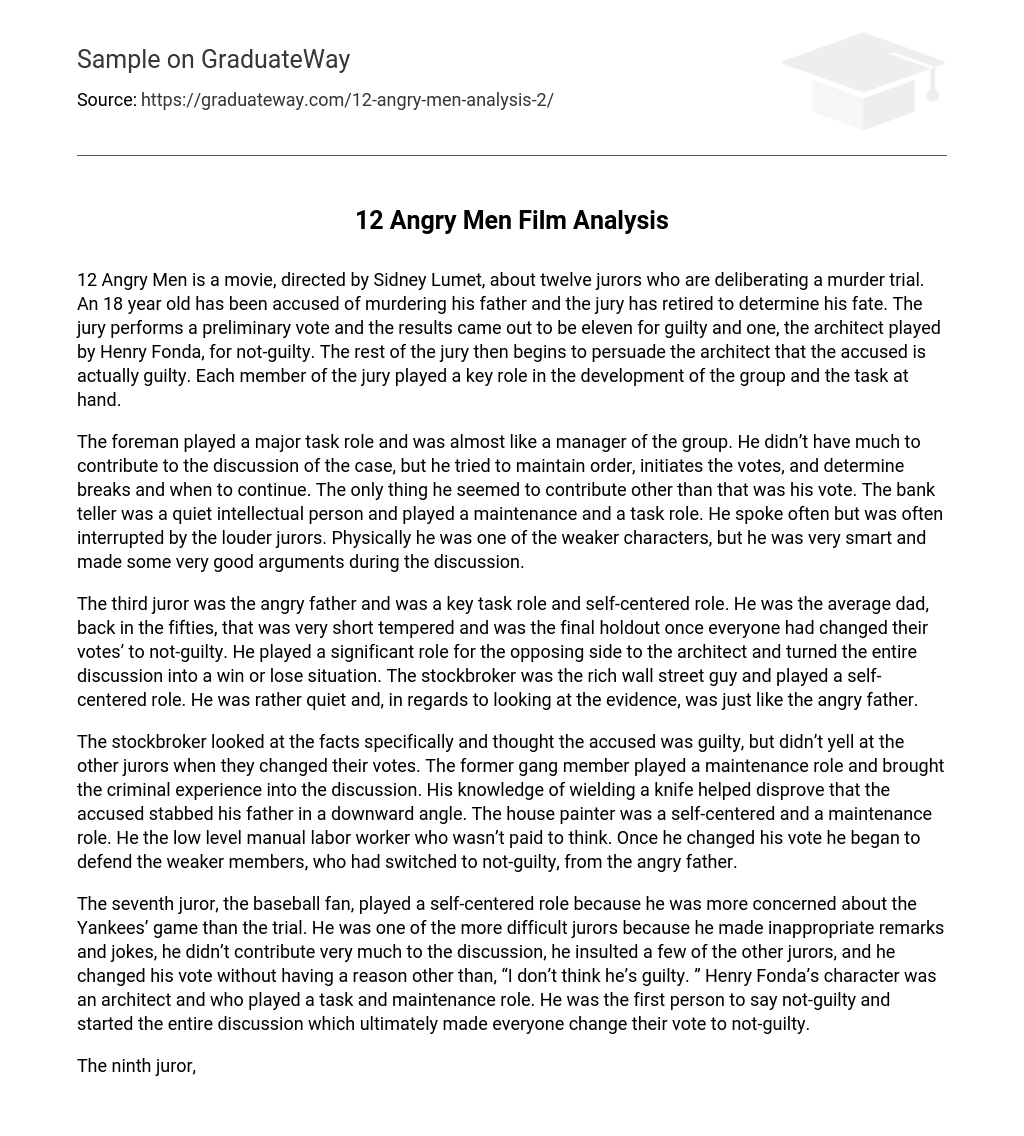Directed by Sidney Lumet, “12 Angry Men” depicts a murder trial in which twelve jurors must decide the fate of an 18-year-old accused of patricide. In the initial vote, eleven jurors find the accused guilty, while Henry Fonda’s character argues for his innocence. The other jurors make efforts to persuade the architect that the defendant is indeed guilty. Each juror contributes significantly to the development of the group and their responsibilities.
The foreman fulfilled a crucial task as a group manager, overseeing order, initiating votes, and dictating breaks. Though he didn’t have much to add to the case discussion, he played an active role. Apart from voting, his contributions were limited. In contrast, the bank teller assumed a reserved but intellectually inclined role, juggling both task and maintenance responsibilities. His frequent interruptions by louder jurors hindered his ability to speak at length. Despite being physically weaker, he showcased his intelligence and effectively presented compelling arguments during the deliberation.
The third juror shouldered the responsibility of being an angry father and served as both a crucial task role and a self-centered role. He embodied the typical 1950s dad, known for his quick temper, and he remained the sole dissenter when everyone else changed their votes to not guilty. He played a significant part in opposing the architect and transformed the entire deliberation into a competition between victory and defeat. The stockbroker, on the other hand, depicted a wealthy Wall Street figure who also maintained a self-centered attitude. Despite his reserved nature, he resembled the angry father when it came to evaluating the evidence.
The stockbroker examined the evidence carefully and believed the defendant was responsible, yet showed restraint when other jurors altered their votes. The ex-gang member fulfilled a supportive role and brought his firsthand knowledge of criminal activities into the deliberation. His understanding of knife handling aided in disproving the claim that the accused had stabbed his father in a downward motion. The house painter, characterized as self-absorbed, also played a supportive role. As a low-level manual laborer, he was not expected to engage in critical thinking. However, after changing his vote, he began to protect the more vulnerable members who had switched to a not-guilty verdict, shielding them from the angered father.
The baseball fan juror, also known as the seventh juror, had a self-centered role in the trial as his main concern was the Yankees’ game. Among the more challenging jurors, he frequently made inappropriate remarks and jokes, contributed minimally to the discussion, insulted several fellow jurors, and changed his vote without providing any reasoning other than stating, “I don’t think he’s guilty.” Meanwhile, playing the role of an architect, Henry Fonda’s character took up a task and maintenance role. He initiated the dialogue by being the first to proclaim a not-guilty verdict, which ultimately led everyone else to change their votes accordingly.
The ninth juror, an elderly man, served as a wise observer in the movie. During a critical moment, the architect decided to change his vote to guilty if the rest of the jury still voted guilty. However, only the old man altered his vote to not-guilty after the vote. He did so because he believed it was challenging to stand alone and desired more information about the trial. Conversely, the tenth juror, a garage owner, exhibited a self-centered and prejudiced attitude. He stubbornly clung to the notion that race or social status determined guilt when it came to the accused.
After some time, it appeared that the defendant’s race was the only argument he had. The defendant, a successful immigrant watchmaker in New York, took on the role of the peacemaker by confronting a baseball fan and emphasizing the importance of making informed decisions. The advertising executive, on the other hand, was portrayed as self-centered and indecisive throughout the film as he continually changed his vote. Ultimately, I believe the jury reached a genuine consensus in their decision-making process.
Initially, I had doubts about their satisfaction, especially when some members altered their votes. However, upon further consideration, I am persuaded that the remaining not-guilty votes were content. Despite initially being resistant to accepting the truth, they eventually acknowledged the verdict and were relieved that an innocent young man was not sentenced to death. The architect convincingly convinced everyone of the accused’s innocence, demonstrating exceptional skills.
At the final moment in the jury’s chamber, an emotional father displayed anger possibly due to the intense personal nature of the discussion. Despite losing the case, he ultimately came to accept the outcome. The tale of 12 Angry Men revolves around a group of 12 complete strangers joining forces to decide the fate of a young man’s life, concluding that no individual should be sentenced to death when there exists even a shred of doubt. Through achieving genuine consensus, the jury gained valuable insights into the justice system, and some members walked away with enduring life lessons.





